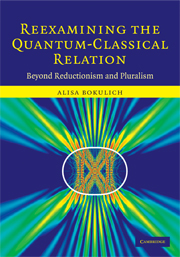Book contents
- Frontmatter
- Contents
- Acknowledgements
- Introduction
- 1 Intertheoretic relations: Are imperialism and isolationism our only options?
- 2 Heisenberg's closed theories and pluralistic realism
- 3 Dirac's open theories and the reciprocal correspondence principle
- 4 Bohr's generalization of classical mechanics
- 5 Semiclassical mechanics: Putting quantum flesh on classical bones
- 6 Can classical structures explain quantum phenomena?
- 7 A structural approach to intertheoretic relations
- References
- Index
7 - A structural approach to intertheoretic relations
Published online by Cambridge University Press: 04 August 2010
- Frontmatter
- Contents
- Acknowledgements
- Introduction
- 1 Intertheoretic relations: Are imperialism and isolationism our only options?
- 2 Heisenberg's closed theories and pluralistic realism
- 3 Dirac's open theories and the reciprocal correspondence principle
- 4 Bohr's generalization of classical mechanics
- 5 Semiclassical mechanics: Putting quantum flesh on classical bones
- 6 Can classical structures explain quantum phenomena?
- 7 A structural approach to intertheoretic relations
- References
- Index
Summary
There are more things in heaven and earth, Horatio, Than are dreamt of in your philosophy.
Shakespeare, Hamlet, Act 1 Scene 5The challenge of semiclassical mechanics: Reassessing the views
Semiclassical mechanics significantly broadens our understanding of the relationship between classical and quantum mechanics. It reveals that there is much more to the relation between these theories than simply showing that classical behavior can be recovered from quantum systems in the limit of large actions (ħ → 0) or large quantum numbers (n → ∞). Although these limits are an important piece of the puzzle, the usual reductionist account of the quantum–classical relation in terms of these limits alone does not tell the whole story.
More specifically, research in semiclassical mechanics has uncovered a number of surprising theoretical and experimental correspondences. Indeed the program of semiclassical research can be broadly understood as the theoretical and experimental task of uncovering these correspondences and extending them in new ways. On the theoretical side, semiclassical methods such as EBK quantization, Gutzwiller's trace formula, and closed orbit theory show how classical structures can be used to construct quantum quantities. These semiclassical methods have proven to be not just useful calculational tools, but also important investigative tools, in that they are often able to provide physical insight into the structure of the quantum dynamics, and hence lead to new discoveries.
- Type
- Chapter
- Information
- Reexamining the Quantum-Classical RelationBeyond Reductionism and Pluralism, pp. 156 - 176Publisher: Cambridge University PressPrint publication year: 2008



